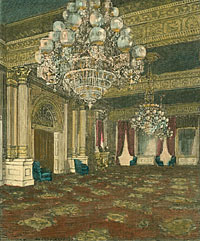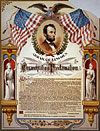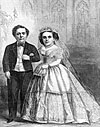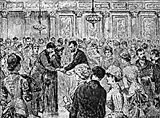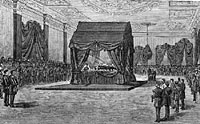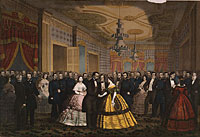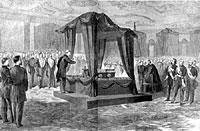Learn More:
The largest room in the White House, the East Room was the site of major social occasions and other events such as such the funerals of Mr. Lincoln’s friend Elmer Ellsworth and President Lincoln himself. The Lincolns held their first “levee” in the East Room just four days after Mr. Lincoln took office. Attorney General Edward Bates described those in attendance as “a motley crowd and terrible squeeze.”1 The room itself was not in much better shape. It was the only room to which tourists had free access and they tended to abuse that freedom. Presidential aide William O. Stoddard noted that the room had “a faded, worn, untidy look, in spite of its frescoing and its glittering chandeliers. Its paint and furniture require renewal; but so does almost everything else about the house, within and without.”2
The Washington Evening Star reported the President’s first levee after his First Inaugural: “But the downright serious hard work of the evening was performed by President Lincoln, who for more than two hours (i.e. from quarter past eight o’clock til half past ten) shook hands in right good earnest with all comers, at the rate of twenty-five per minute, (as timed by a gentleman in his vicinity) or one thousand five hundred per hour.”
The last scene of the levee was a tragic one. The mob of coats, hats and caps left in the hall had somehow got inextricably mixed up and misappropriated, and perhaps not one in ten of that large assemblage emerged with the same outer garments they wore on entering. Some thieves seem to have taken advantage of the opportunity to make a grand sweep, and a very good business they must have done. Some of the victims utterly refusing to don the greasy, kingy apologies for hats left on hand, tied up their heads in handkerchiefs and so wended their way sulkily homeward.”3
The East Room’s disrepair worsened early in the Lincoln Administration when soldiers were stationed there and helped ruin the carpet with their boots and the ceiling with the guns. In April 1861, the Frontier Guards (“Kansas Warriors”) under Major David Hunter and Kansas’ James Lane drilled and slept here while panic gripped the Capital in the wake of Fort Sumner. On April 19, Lincoln aide John Hay recorded in his diary: “About midnight we made a tour of the house. Hunter and the Italian exile Vivaldi were quietly asleep on the floor of the East Room, and a young and careless guard loafed around the furnace fires in the basement. Good-looking and energetic young fellow, too good to be food for gunpowder, – if anything is.”4 According to historian Ronald D. Rietveld, the soldiers “slept on the president’s rich Brussels carpet and stacked their arms down the center of the transverse hall. Instructed not to allow anyone into the East Room without giving the password, they refused admission to see the president. ‘Even the President, when he attempted to enter the hall, accompanied by his lad and some members of the cabinet, was pricked with the sharp steel of the sentinel, and told – perhaps jocosely – that he could not possibly come in!'”5
But after the active hostilities commenced and the soldiers moved out, Mrs. Lincoln began redecorating of the White House, focusing on the East Room. “The famous East Room of the White House is in a state of temporary dilapidation, unfurnished, uncarpeted, all that staring and stunning old paper scraped from the walls, and everything in readiness for its new and becoming winter dress,” wrote presidential aide William O. Stoddard in 1861. “The number of distinguished visitors is already beginning to increase, and soon the tide will fairly set in.”6
Under Mrs. Lincoln’s redecorating, a large pale green rug (imported from Belgium) was reflected – along with three big chandeliers and new drapes – in the mirrors that lined the walls. Frequently after receiving guests for two hours at the Tuesday or Saturday receptions. Mr. and Mrs. Lincoln made a “promenade” around the room. According to William Stoddard: “It is the breaking up of the reception, and it is performed without any prescribed order or formality. There are no rules of precedence, and this is dangerous coasting ground for what is called etiquette. The crowd in the East Room is dense. It is enjoying itself, and it will hardly get out of the way to let the President’s official procession perform its walk around, although the Marine Band is manifestly changing its musical storm-mixture into the first notes of ‘Hail Columbia.’ There it comes, in full force and blast, and it is the signal for everybody to go home.”7
At first, President & Mrs. Lincoln did not parade together, but the ever-jealous Mary Todd objected to their separation. Mrs. Lincoln changed the protocol of White House social events, as related by her seamstress and friend, Elizabeth Keckley:
‘Lizabeth!’–I was sewing in her room, and she was seated in a comfortable arm-chair–‘Lizabeth, I have been think over a little matter. As you are well aware, the President, at every reception, selects a lady to lead the promenade with him. Now it occurs to me that this custom is an absurd one. On such occasions our guests recognize the position of the President as first of all; consequently, he takes the lead in everything; well, now, if they recognize his position they should also recognize mine. I am his wife, and should lead with him. And yet he offers his arm to any other lady in the room, making her first with him and placing me second. The custom is an absurd one, and I mean to abolish it. The dignity that I owe to my position, as Mrs. President, demands that I should not hesitate any longer to act.’
Mrs. Lincoln kept her word. Ever after this, she either led the promenade with the President, or the President walked alone or with a gentleman. The change was much remarked, but the reason why it was made, I believe, was never generally known.8
The “democratic” nature of these occasions did not make for either order or security — as Secretary of the Navy Gideon Welles complained to his diary on April 20, Wednesday, 1864: “The past public evening reception of the season took place last evening at the Executive Mansion. It was a jam, not creditable in its arrangements to the authorities. The multitude were not misbehaved, farther than crowding together in disorder and confusion may be so regarded. Had there been a small guard, or even a few police officers, present, there might have been regulations which would have been readily acquiesced in and observed. There has always been a want of order and proper management at these levees or receptions, which I hope may soon be corrected.”9
Guard William Crook said his first levee on January 9, 1965 was a “spectacle [that] awed me at first. I had never seen anything like it before. The reception, or ‘levee,’ as the name was then, was crowded. It was generally considered a brilliant affair. I know it dazzled me.”
The President and Mrs. Lincoln stood in the octagon Blue Room, near the western door. I was in the main entrance just outside, near where the broad flight of steps used to go up to the second floor. The guests entered the northern door, left their wraps in the cloak-rooms which had been constructed in the corridor, assembled in the Red Room, made their way to the Blue Room, where they were received. Then they progressed, greeting friends in the crowd, through the Green Room to the great East Room, where they remained. On the right of the President was Mr. John G. Nicolay, one of the two secretaries; on his left Deputy-Marshal Phillips. Commissioner [Benjamin Brown French] presented the guests to Mrs. Lincoln. I suppose I could hardly be expected to remember what the ladies wore. But my wife saw in the paper the next day that Mrs. Lincoln wore white silk trimmed with black lace. She had a wreath of white flowers in her hair, and wore a necklace of white pearls. I suppose the costume, hoop-skirts and all, would look ugly to me to-day. But we all thought Mrs. Lincoln looked handsome. To my mind she was a pretty woman, small and plump, with a round, baby face and bright black eyes. Senator Sumner was present, and Senator Chase with a party. That reminds me of what was to me the most exciting moment of the reception.
My orders were to allow no one who wore wraps of any kind to pass into the Blue Room. The reason for this is not hard to find. Precautions against violence were being redoubled, and this was one of them. It would be the easiest thing in the world for a would-be assassin to smuggle weapons in under the voluminous cloaks then worn. It had been announced that guests were expected to leave their wraps in one of the rooms appointed for them. I had been instructed to make absolutely no exceptions. The newspapers the next day said: ‘The rule of decorum relating to wraps was very generally observed.’ They didn’t know about my little experience.
Several guests had attempted to enter still wearing their cloaks. But no one resisted the order when it was made known. Finally a very handsome young woman came in who asked for Senator Chase’s party. She wore a wrap that completely hid her dress. She could have brought in a whole arsenal of weapons under its folds. I told her that she could not enter until she left her cloak in the cloak room. She became angry.
“Do you know who I am,’ she demanded, haughtily. I was rather nervous, for it was my first experience saying ‘Must not!’ to White House guests. But I managed to say I did not know who she was.
‘I am Mrs. Senator Sprague,’ she announced, as if that were final. I had heard of Kate Chase Sprague, of course, as had every one else in Washington, and of her father’s ambition and her own brilliant career. But I tried to be courageous, and told her as politely as I could what my orders were and why they were given. When she saw the reason of the restriction she took off her cloak quite graciously and went in to meet her friends.
By this time most of the guests had arrived, so I had an opportunity to look about me. It was all bright and gay. For this evening at least there was no sign of the gloom that was pretty general throughout the city.
The people who crowded the rooms were in keeping with their brilliant character. The men were marked by a shade of extravagance in the cut and material of their evening clothes. There were many army officers in full uniform among the guests. The women looked like gorgeous flowers in their swaying, buoyed-out skirts. They were gayly dressed, as a rule, with the off-shoulder style of low-necked gown; they all wore wreaths of flowers in their hair. The general effect of the scene was brilliant.
About eleven the President, with Mrs. Dennison, the wife of the new Postmaster-General, on his arm, followed by Mrs. Lincoln escorted by Senator [Edwin D. Morgan], entered the East Room. They talked for a few minutes with their guests and then retired – Mrs. Lincoln to her own room and the President to the library up-stairs. The levee was supposed to be over at eleven, but some people remained until nearly twelve.10
There was a good deal of ceremony connected with these events and they could be tiring on Mr. and Mrs. Lincoln. Michael Burlingame wrote: “When Benjamin Brown French, who referred to Mrs. Lincoln as ‘The Queen,’ introduced callers to her, she cursteyed and asked ‘How do you do?’ She addressed friends with a cordial, ‘I am glad to see you’ and presented her gloved fignertips to indicate her pleasure.”11 Mary Abigail Dodge said to President Lincoln at one reception: “Mr. Lincoln, I am very sorry for you, but indeed I must shake hands with you.” President Lincoln responded to the diminutive woman: “Ah! Your hand doesn’t hurt me.”12
William O. Stoddard described the conclusion of one reception: “The hour came at least for the President to make a promenade into and through the East Room. It was the breaking up of the reception, and it was performed without any prescribed order or formality. There were no rules of precedence, and this was dangerous coasting ground for what was called etiquette. The crowd in the East Room was dense. It was enjoying itself and would hardly get out of the way to let the President’s official procession perform its walk-around, although the Marine band was manifestly changing its musical mixture into the first notes of ‘Hail, Columbia.’ Then it came full blast – the signal for everybody to go home.”13
President Lincoln met with visiting Native American chiefs in the East Room on at least two occasions. On April 30, 1861 John Hay recorded the President’s meeting: “Three Indians of the Pottawatomies called today upon their Great Father. The Spokesman’s English was very exceptional, the other two were mute. One was a magnificent broad-chested, bare armed giant with a barbaric regal adornment of bears claws. The second a quiet Uncas looking fellow. The Spokesman was dressed in a wonderful style of shabby genteel. The President amused them greatly by airing the two or three Indian words he knew. I was amused by his awkward efforts to make himself understood by speaking bad English, e.g., ‘Where live now? When go back Iowa?'”14 On March 27, 1863, the President’s English improved in speaking to several other Indian chiefs: “It is the object of this Government to be on terms of peace with you, and with all our red brethern. We constantly endeavor to be so. We make treaties with you, and will try to observe the; and if our children should sometimes behave badly, and violate these treaties, it is against our wish.”15
The funeral of Lincoln protege Elmer Ellsworth was held here on May 25, 1861 after he was killed in Alexandria when he had torn down a Confederate Flag. The 24-year-old colonel, virtually a member of the Lincoln family, had been leading his Zouave regiment of New York Fire Department members in an occupation of the Virginia side of the Potomac River. His charisma attracted thousands of soldiers and residents to his wake where he was laid out in his colorful Zouave uniform. He was killed after cut down the Confederate flag which was flying over a house in Alexandria. All the Lincolns were deeply grieved by his death — virtually the first one on the Washington front. The President himself accompanied the funeral hearse away from the White House. He had been in his office when the news of Ellsworth’s death had arrived and burst into tears, saying later, “I will make no apology, gentlemen, for my weakness, but I knew poor Ellsworth well and held him in high regard.”16
It was here four years later that President Lincoln’s funeral was held.
Footnotes
- Edward Bates,The Diary of Edward Bates, p. 177.
- William O. Stoddard,Inside the White House in Lincoln Times, p. 13.
- Allen C. Clark, Abraham Lincoln in the National Capital,Journal of the Columbia Historical Society, Volume XXVII, p. 16 (Washington Evening Star, March 9, 1861) 4. Michael Burlingame and John R. Turner Ettlinger, editors,Inside Lincoln’s White House: The complete Civil War Diary of John Hay, p. 3.
- Michael Burlingame, editor,Dispatches from Lincoln’s White House: The Anonymous Civil War Journalism of Presidential Secretary William O. Stoddard, p. 37.
- Ronald D. Rietveld, “The Lincoln White House Community,”Journal of the Abraham Lincoln Association, p. 25.
- Michael Burlingame, editor,Inside the White House in War Times,.p. 53. 8. Elizabeth Keckley,Behind the Scenes, pp. 144-145.
- Gideon Welles,Diary of Gideon WellesVolume II, p. 15.
- Margarita Spalding Gerry, editor,Through Five Administrations: Reminiscences of Colonel William H. Crookpp. 5-10
- Michael Burlingame,Abraham Lincoln: A Life, Volume II, p. 260.
- Gail Hamilton,Gail Hamilton’s Life in Letters, p. 314.
- William O. Stoddard, Jr., editor,Lincoln’s Third Secretary, p. 131.
- Michael Burlingame and John R. Turner Ettlinger, editors,Inside Lincoln’s White House: The complete Civil War Diary of John Hay, p. 14.
- Roy P. Basler, editor,Collected Works of Abraham Lincoln, Volume VI, pp. 151-153.
- Ruth Painter Randall,Colonel Elmer Ellsworth, p. 262.
Visit
Elmer Ellsworth
Mary Todd Lincoln
James H. Lane
John Hay
Elizabeth Keckley

